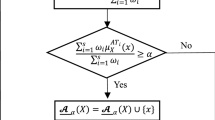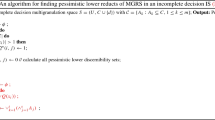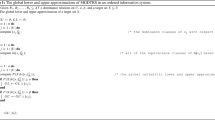Abstract
The multiple granular structures in multigranulation approximation space can be integrated by different approximation operators. These operators are induced by multigranulation rough set or others. In this paper, numerical algorithms of attributes set reduction are developed by using evidence theory or minimal elements of discernibility matrix, respectively. Firstly, a pair of multi-source rough approximation operators and their corresponding multigranulation rough approximation operators are defined based on a bijective and new transitional domain. Then, we propose attributes set reduction with respect to multi-source rough approximation. It is based on the relationship between multi-source rough approximations and evidence theory. Therefore, a heuristic algorithm of attributes set reduction for multi-source lower rough approximation is given. Secondly, we define a multigranulation variable precision rough set (MVRS) by considering weight of each attributes set relative to all of attributes sets. Finally, we investigate attributes set reduction with MVRS by combing the minimal elements of discernibility matrix and distribution discernibility function. There are some illustrative examples to elaborate the operation mechanism of above conclusions.
Similar content being viewed by others
Explore related subjects
Discover the latest articles, news and stories from top researchers in related subjects.References
Khan M, Banerjee M (2008) Formal reasoning with rough sets in multiple-source approximation systems. Int J Approx Reason 49(2):466–477
Pawlak Z (1982) Rough sets. Int J Comput Inf Sci 11(5):341–356
Tan A, Li J, Lin G (2015) Extended results on the relationship between information systems. Inf Sci 290:156–173
Chen D, Kwong S, He Q, Wang H (2012) Geometrical interpretation and applications of membership functions with fuzzy rough sets. Fuzzy Sets Syst 193:122–135
Jiang S, Mi J, Ma L (2015) Computational reasoning based on complemented distributive lattices[J]. Int J Mach Learn Cybern 6(3):475–478
Wu W, Zhang M, Li H, Mi J (2005) Knowledge reduction in random information systems via Dempster–Shafer theory of evidence. Inf Sci 174(3):143–164
Mi J, Zhang W (2004) An axiomatic characterization of a fuzzy generalization of rough sets. Inf Sci 160(1):235–249
Li J, Ren Y, Mei C, Qian Y (2016) A comparative study of multigranulation rough sets and concept lattices via rule acquisition. Knowl Based Syst 91:152–164
Li J, Mei C, Lv Y (2013) Incomplete decision contexts: approximate concept construction, rule acquisition and knowledge reduction. Int J Approx Reason 54(1):149–165
Lin G, Liang J, Qian Y (2015) An information fusion approach by combining multigranulation rough sets and evidence theory. Inf Sci 314:184–199
Wu W, Leung Y, Zhang W (2002) Connections between rough set theory and Dempster–Shafer theory of evidence. Int J Gen Syst 31(4):405–430
Chen D, Zhang X, Li W (2015) On measurements of covering rough sets based on granules and evidence theory. Inf Sci 317:329–348
Feng T, Zhang S, Mi J (2012) The reduction and fusion of fuzzy covering systems based on the evidence theory. Int J Approx Reason 53(1):87–103
Chen D, Li W, Kwong S (2014) Evidence-theory-based numerical algorithms of attribute reduction with neighborhood-covering rough sets. Int J Approx Reason 55(3):908–923
Yang Y, Chen D, Dong Z (2014) Novel algorithms of attribute reduction with variable precision rough set model. Neurocomputing 139:336–344
Mi J, Wu W, Zhang W (2004) Approaches to knowledge reduction based on variable precision rough set model. Inf Sci 159(3):255–272
Chen D, Yang Y, Dong Z (2016) An incremental algorithm for attribute reduction with variable precision rough sets. Appl Soft Comput 45:129–149
Chen D, Wang C, Hu Q (2007) A new approach to attribute reduction of consistent and inconsistent covering decision systems with covering rough sets. Inf Sci 177(17):3500–3518
Ma L, Mi JS, Xie B (2016) Multi-scaled concept lattices based on neighborhood systems [J]. Int J Mach Learn Cybern 8(1):1–9
Dubois D, Prade H (1990) Rough fuzzy sets and fuzzy rough sets. Int J Gen Syst 17(2–3):191–209
Wang C, Qi Y, Shao M (2017) A fitting model for feature selection with fuzzy rough sets. IEEE Trans Fuzzy Syst 25(4):741–753
Wang C, Hu Q, Wang X (2017) Feature selection based on neighborhood discrimination index. IEEE Trans Neural Netw Learn Syst 99:1–14
Wang C, Shao M, He Q (2016) Feature subset selection based on fuzzy neighborhood rough sets. Knowl Based Syst 111:173–179
Tan A, Wu W, Li J, Lin G (2016) Evidence-theory-based numerical characterization of multigranulation rough sets in incomplete information systems. Fuzzy Sets Syst 294:18–35
Qian Y, Li S, Liang J, Shi Z, Wang F (2014) Pessimistic rough set based decisions: a multigranulation fusion strategy. Inf Sci 264:196–210
Ju H, Yang X, Dou H, Song J (2014) Variable precision multigranulation rough set and attributes reduction. In: Peters J, Skowron A, Li T, Yang Y, Yao J, Nguyen H (eds) Transactions on Rough Sets XVIII. Lecture Notes in Computer Science, vol 8449. Springer, Berlin, Heidelberg
Dempster A (1967) Upper and lower probabilities induced by a multivalued mapping. Ann Math Stat 38(2):325–339
Shafer G (1976) A mathematical theory of evidence. Princeton University Press, Princeton
Wu W, Qian Y, Li T, Gu S (2016) On rule acquisition in incomplete multi-scale decision tables. Inf Sci. ISSN 0020-0255
Qian Y, Liang J, Yao Y, Dang C (2010) MGRS: a multi-granulation rough set. Inf Sci 180(6):949–970
Acknowledgements
This paper is supported by Grants of National Natural Science Foundation of China (61573127, 61502144, 61300121, 61472463), Natural Science Foundation of Hebei Province (A2014205157) and the Natural Science Foundation of Higher Education Institutions of Hebei Province (QN2016133).
Author information
Authors and Affiliations
Corresponding author
Additional information
Publisher's Note
Springer Nature remains neutral with regard to jurisdictional claims in published maps and institutional affiliations.
Rights and permissions
About this article
Cite this article
Che, X., Mi, J. Attributes set reduction in multigranulation approximation space of a multi-source decision information system. Int. J. Mach. Learn. & Cyber. 10, 2297–2311 (2019). https://doi.org/10.1007/s13042-018-0868-8
Received:
Accepted:
Published:
Issue Date:
DOI: https://doi.org/10.1007/s13042-018-0868-8




